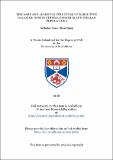The dark and luminous structure of early-type galaxies : observational dynamics and stellar populations
Abstract
Lenticular and elliptical galaxies, collectively referred to as "early-type galaxies" (ETGs), are
commonly thought to represent the end-points of galaxy evolution. Lying in the red sequence
of galaxies, these objects are defined by their mostly old stellar populations and by their "red
and dead" appearance in optical observations. Much progress in understanding these objects
has been made with integral-field spectroscopy in recent years, with results repeatedly pointing
to a link between early-type galaxies and high-redshift spiral galaxies. However, the exact
nature of this link remains unclear, with a wide variety of evolution scenarios likely required
to fully explain the range of observed early-type galaxy properties.
In my study, I analysed observations of twelve early-type galaxies taken with the Mitchell
Integral-Field Spectrograph at McDonald Observatory, Texas. These galaxies have previously
been found to contain detectable quantities of neutral hydrogen gas, with ten out of the twelve
displaying large-scale hydrogen disks. I extracted line-of-sight kinematics of the stellar and
ionised gas components of these galaxies, and I used various modelling approaches to constrain
their stellar population parameters as well as their three-dimensional mass structure in terms
of both dark and visible components. An important feature of this study is the wide field of
view of the spectroscopic observations, which reach beyond two half-light radii for almost all
of the sample; this remains rare for integral-field unit (IFU) studies of ETGs, and so sets this
study apart from most earlier works. The gas-rich nature of the sample is likewise novel. I find
all aspects of my analysis to yield a consistent view of these galaxies’ evolution, in which one or
more gaseous interaction events served to shape them into their observed forms. I find these
galaxies to contain low dark matter fractions on average within the inner half-light radius, and
I also find mass modelling to favour near-isothermal total density profiles over much of the
sample.
Type
Thesis, PhD Doctor of Philosophy
Collections
Items in the St Andrews Research Repository are protected by copyright, with all rights reserved, unless otherwise indicated.

